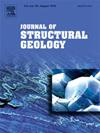巴西东北部Itapetim和Tendó剪切带中地壳各向异性应变局部化和流变减弱
IF 2.9
2区 地球科学
Q2 GEOSCIENCES, MULTIDISCIPLINARY
引用次数: 0
摘要
巴西东北部borborrema省中部(CBP)拥有保存完好的中地壳剪切带,该剪切带形成于泛非造山运动时期的走滑构造背景下。这些构造是研究高温大陆剪切带强度控制过程的关键,这些构造往往在后期的地质记录中被抹去。我们利用野外制图、微组构分析和矿物化学相结合的方法,分析了CBP中两个主要的北东向剪切带Itapetim和Tendó剪切带(ISZ和TSZ)中的糜棱岩和超长岩。ISZ和TSZ主要由花岗质糜棱岩组成,具有离散的薄超长岩层。在糜棱岩中,钾长石卟啉碎屑形成了一个承载框架,通过微压裂、位错-滑动控制变形和晶界迁移进行变形。塑性应变优先适应于不连续的单矿物石英带和富斜长石层交替发生。超长晶石层在空间和成因上与石英脉和胶结岩脉有关,其中流体-岩石相互作用导致应变软化。这一过程导致金绢石衍生的钾长石新母细胞和富黑云母层的发育,进一步增强了流变弱化作用。研究结果表明,应变沿岩性边界优先定位,形成了符合borborrema省中部地块整体构造背景的左旋剪切带。我们的发现证明了这些北东向左旋剪切带与束缚它们的主要东西向右旋构造之间的应变兼容性,为大陆造山带碰撞后阶段流变减弱的机制提供了有价值的见解。本文章由计算机程序翻译,如有差异,请以英文原文为准。
Strain localization and rheological weakening along mid-crustal anisotropies as recorded in the Itapetim and Tendó shear zones (northeastern Brazil)
The Central Borborema Province (CBP) in NE Brazil hosts well-preserved mid-crustal shear zones that formed during the Pan-African orogeny in a strike-slip tectonic setting. These structures are key to investigate the strength-controlling processes in high-temperature continental shear zones, which are often obliterated from the geological record during late exhumation. We have analyzed mylonites and ultramylonites from the Itapetim and Tendó shear zones (ISZ and TSZ), two major NE-trending shear zones in the CBP, using a combination of field mapping, microfabric analysis and mineral chemistry. Both the ISZ and TSZ are primarily composed of granitic mylonites with discrete, thin ultramylonitic layers. In mylonites, K-feldspar porphyroclasts form a load-bearing framework that deforms through microfracturing, dislocation-glide-controlled deformation and grain boundary migration. Plastic strain is preferentially accommodated in discontinuous monomineralic quartz ribbons alternating with plagioclase-rich layers. The ultramylonitic layers are spatially and genetically associated with quartz veins and aplitic dykes, in which fluid-rock interactions induce strain softening. This process leads to the development of myrmekite-derived K-feldspar neoblasts and biotite-rich layers, further enhancing rheological weakening. The data gathered in this study suggest that strain is preferentially localized along lithological boundaries, resulting in the development of sinistral shear zones that conform to the overall tectonic setting of the central block of the Borborema Province. Our findings demonstrate strain compatibility between these NE-trending sinistral shear zones and the major E-W dextral lineaments that bound them, offering valuable insights into the mechanisms of rheological weakening in the post-collisional stage of continental orogens.
求助全文
通过发布文献求助,成功后即可免费获取论文全文。
去求助
来源期刊

Journal of Structural Geology
地学-地球科学综合
CiteScore
6.00
自引率
19.40%
发文量
192
审稿时长
15.7 weeks
期刊介绍:
The Journal of Structural Geology publishes process-oriented investigations about structural geology using appropriate combinations of analog and digital field data, seismic reflection data, satellite-derived data, geometric analysis, kinematic analysis, laboratory experiments, computer visualizations, and analogue or numerical modelling on all scales. Contributions are encouraged to draw perspectives from rheology, rock mechanics, geophysics,metamorphism, sedimentology, petroleum geology, economic geology, geodynamics, planetary geology, tectonics and neotectonics to provide a more powerful understanding of deformation processes and systems. Given the visual nature of the discipline, supplementary materials that portray the data and analysis in 3-D or quasi 3-D manners, including the use of videos, and/or graphical abstracts can significantly strengthen the impact of contributions.
 求助内容:
求助内容: 应助结果提醒方式:
应助结果提醒方式:


